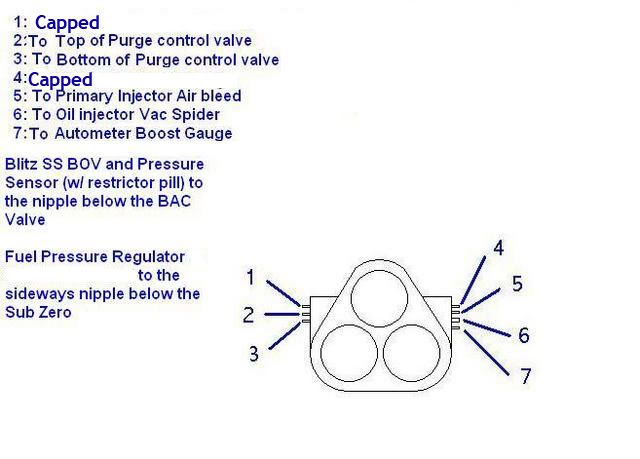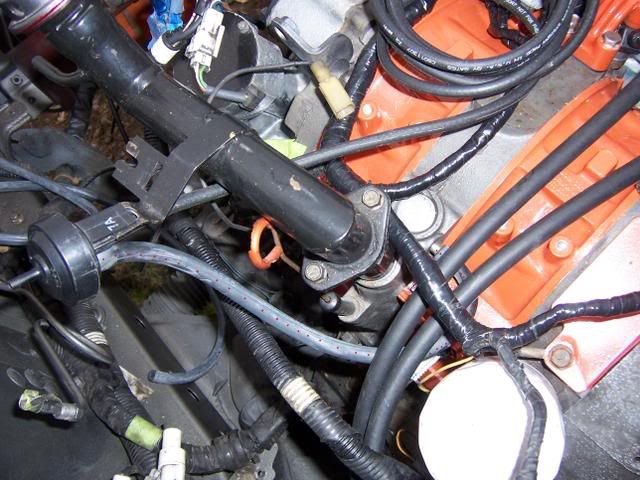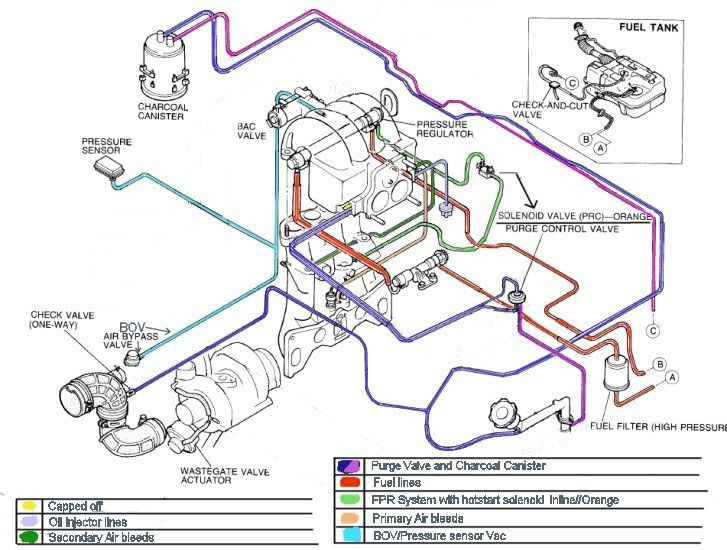TII Purge Valve System Discussion
#1
TII Purge Valve System Discussion
So after a few hours of research and looking through the Haynes manual I still have some questions. The main reason for me asking about this is I have the dreaded lung mustard and rusty oil fill issue.
Looking in the haynes manual: I see the hose close to the oil fill cap (at the top of the tube) goes to the Purge Control Valve. Specifically it is connected to the side of the PCV valve with two nipples, which one does the line from the oil fill connect to?
The side of the PCV valve with only one line, the manual shows it goes to before the throttle plates. Are there any locations you guys typically use for this connection?
Then on the other connection of the PCV valve with two nipples it shows the connection after the throttle plates, Same question, are there any preferred locations for this connection?
The nipple on the center plate at the base of the oil fill shows connected to a T where it is connected to the charcoal canister and the other is connected to the TID. Do we still want to connect that line to the TID? I would think we would want to prevent junk from getting on the turbo. If so where do I connect the line that would originally go to the TID?
If it makes a difference I am running a standalone
Looking in the haynes manual: I see the hose close to the oil fill cap (at the top of the tube) goes to the Purge Control Valve. Specifically it is connected to the side of the PCV valve with two nipples, which one does the line from the oil fill connect to?
The side of the PCV valve with only one line, the manual shows it goes to before the throttle plates. Are there any locations you guys typically use for this connection?
Then on the other connection of the PCV valve with two nipples it shows the connection after the throttle plates, Same question, are there any preferred locations for this connection?
The nipple on the center plate at the base of the oil fill shows connected to a T where it is connected to the charcoal canister and the other is connected to the TID. Do we still want to connect that line to the TID? I would think we would want to prevent junk from getting on the turbo. If so where do I connect the line that would originally go to the TID?
If it makes a difference I am running a standalone
#2
I thought I had mine hooked up right but now I think I might have two lines backwards......
Basically I have the purge control valve hooked up like this: Vac port 2 goes to the top of the PCV, vac port 3 to the bottom. The other bigger line on the bottom of the PVC valve goes to the line at the base of the oil fill tube.
Then the line from the top of the oil fill is teed into the line from the charcoal canister and they both run to the TID, there is a check valve in the line before the TID.
According to what your saying, the line from the top of the oil fill should go to the PCV and the line from the bottom of thoil fill should get teed with the charcoal canister?
I am going to check it out and get back to you but I am not sure right now. I would like to make sure that it's correct though before I start driving around.
Can anyone else confirm how this is supposed to be setup?




Basically I have the purge control valve hooked up like this: Vac port 2 goes to the top of the PCV, vac port 3 to the bottom. The other bigger line on the bottom of the PVC valve goes to the line at the base of the oil fill tube.
Then the line from the top of the oil fill is teed into the line from the charcoal canister and they both run to the TID, there is a check valve in the line before the TID.
According to what your saying, the line from the top of the oil fill should go to the PCV and the line from the bottom of thoil fill should get teed with the charcoal canister?
I am going to check it out and get back to you but I am not sure right now. I would like to make sure that it's correct though before I start driving around.
Can anyone else confirm how this is supposed to be setup?




Trending Topics
#8
Can you elaborate?
Do you just run the hose that would go to the TID to the catch can? Do you still use the check valve?
If you just run two lines to the catch can...from the oil fill neck/center iron to it. How do you get the crankcase gasses to flow to it? Do you still have to use the PCV valve to draw vacuum?
Where do I get a 'nice' catch can rather than a pepsi bottle?
Do you just run the hose that would go to the TID to the catch can? Do you still use the check valve?
If you just run two lines to the catch can...from the oil fill neck/center iron to it. How do you get the crankcase gasses to flow to it? Do you still have to use the PCV valve to draw vacuum?
Where do I get a 'nice' catch can rather than a pepsi bottle?
#9
Can you elaborate?
Do you just run the hose that would go to the TID to the catch can? Do you still use the check valve?
If you just run two lines to the catch can...from the oil fill neck/center iron to it. How do you get the crankcase gasses to flow to it? Do you still have to use the PCV valve to draw vacuum?
Where do I get a 'nice' catch can rather than a pepsi bottle?
Do you just run the hose that would go to the TID to the catch can? Do you still use the check valve?
If you just run two lines to the catch can...from the oil fill neck/center iron to it. How do you get the crankcase gasses to flow to it? Do you still have to use the PCV valve to draw vacuum?
Where do I get a 'nice' catch can rather than a pepsi bottle?
IF running a catch can would this be right.
- Cap off both connections on the manifold where the PCV valve was connected
- Cap off the TID
- Cap off the nipple on the center iron.
- Run a hose from the oil filler neck to the catch can, since the catch can has two openings and needs to be vented then the 2nd nipple should have a breather on it.
right or wrong?
#10
No you would run both lines to the catch can. One from the oil fill neck and one from the nipple on the center iron. The purge valve just regulates when the vapors are let back into the intake, if you are running a catch can they can just vent as they need to.
#11
Read FSM page 4B-88:

Look at the part of the diagram with the solid arrows. More gases are physically expelled as combustion pressure increase (more combustion pressure = less manifold vacuum). The oily gases push themselves out of the crankcase (internal pressure). On a factory vehicle the crap pushed out under WOT is recirculated back into the engine before the turbo as is shown in the diagram. If you completely block off the main crankcase vents, you WILL have blue smoke. I have seen it before. If you have a catch can the oily crap will be captured in there instead of back in your intake tract. I rarely have much crap in my catch can though, but I have an oil pan baffle which may reduce the amount of oil being expelled out due to sloshing around.
Take a look at the top set of non-solid arrows. On the bottom part of the PCV valve, a vacuum source (bottom UIM nipple, left line in the pic) under low load pulls the valve open. I believe this allows the gases from the oil filler to be drawn through the top of the PCV valve, to the middle UIM nipple which goes before the throttle plates. This small volume of combustion gases is externally pulled by manifold vacuum instead of being internally pushed out by the crankcase, as under WOT.
Comparatively speaking, very little combustion gases are actually drawn out by low-load vacuum through the PCV valve itself and that is mostly an emissions function. If you don't care about emissions, the PCV valve is practically useless because it's not needed to prevent nasty blowby under load, not when you can just vent it to a catch can.
The charcoal canister and evaporative emissions system have a different purpose than the main WOT crankcase ventilation. If I understand them correctly, the WOT ventilation and Evap system are just tee'd together, but don't operate under the same conditions. Under low load the fuel tank vapors are drawn in before the turbo--via the tee it is the same location that the PCV gases are expelled under WOT. The check valve then makes sure the gases only flow toward the TID. The previous owner of my car removed my charcoal canister and I haven't taken the time to see exactly how he went about doing it. I don't have any complaints about it being gone though, although some people say it will result in a fuel smell.
If you are running a catch can you could just put the nipple on the middle iron and the nipple on the filler tube directly to the can, and the can will have a breather filter on top. That's how I have mine. I haven't looked as much into the charcoal canister vacuum routing, but if you want to keep it on the car you might be able to just route it back before the turbo just how it is from the factory. Drill and tap your custom TID 1/8" NPT, and install a 1/8 NPT --> 3/16" brass hose barb fitting so you can run a hose there.

Look at the part of the diagram with the solid arrows. More gases are physically expelled as combustion pressure increase (more combustion pressure = less manifold vacuum). The oily gases push themselves out of the crankcase (internal pressure). On a factory vehicle the crap pushed out under WOT is recirculated back into the engine before the turbo as is shown in the diagram. If you completely block off the main crankcase vents, you WILL have blue smoke. I have seen it before. If you have a catch can the oily crap will be captured in there instead of back in your intake tract. I rarely have much crap in my catch can though, but I have an oil pan baffle which may reduce the amount of oil being expelled out due to sloshing around.
Take a look at the top set of non-solid arrows. On the bottom part of the PCV valve, a vacuum source (bottom UIM nipple, left line in the pic) under low load pulls the valve open. I believe this allows the gases from the oil filler to be drawn through the top of the PCV valve, to the middle UIM nipple which goes before the throttle plates. This small volume of combustion gases is externally pulled by manifold vacuum instead of being internally pushed out by the crankcase, as under WOT.
Comparatively speaking, very little combustion gases are actually drawn out by low-load vacuum through the PCV valve itself and that is mostly an emissions function. If you don't care about emissions, the PCV valve is practically useless because it's not needed to prevent nasty blowby under load, not when you can just vent it to a catch can.
The charcoal canister and evaporative emissions system have a different purpose than the main WOT crankcase ventilation. If I understand them correctly, the WOT ventilation and Evap system are just tee'd together, but don't operate under the same conditions. Under low load the fuel tank vapors are drawn in before the turbo--via the tee it is the same location that the PCV gases are expelled under WOT. The check valve then makes sure the gases only flow toward the TID. The previous owner of my car removed my charcoal canister and I haven't taken the time to see exactly how he went about doing it. I don't have any complaints about it being gone though, although some people say it will result in a fuel smell.
If you are running a catch can you could just put the nipple on the middle iron and the nipple on the filler tube directly to the can, and the can will have a breather filter on top. That's how I have mine. I haven't looked as much into the charcoal canister vacuum routing, but if you want to keep it on the car you might be able to just route it back before the turbo just how it is from the factory. Drill and tap your custom TID 1/8" NPT, and install a 1/8 NPT --> 3/16" brass hose barb fitting so you can run a hose there.
#15
So did you end up installing the catch can. I actually have decided to go that route myself when I do my next series of mods. I am going to be making some changes to the engine bay in the next couple weeks and will be including a catch can just to make it simpler. My catch can should be here in a few days, I'll post the install in case it helps any one.
#16
Ok I did go with the catch can. I got a gunmetal catch can from Ebay for $25.
The only problem was that it wasn't vented. I drilled a hole in the top, put in a gromet. Then I put a 1/2" double sided barb connector and put the breather on it. Works like a charm.
Except for the fact I ran out of red silicone hose. Anyone know a good place to get this stuff?



The only problem was that it wasn't vented. I drilled a hole in the top, put in a gromet. Then I put a 1/2" double sided barb connector and put the breather on it. Works like a charm.
Except for the fact I ran out of red silicone hose. Anyone know a good place to get this stuff?



#19
I thought this would be useful for you guys to look at it, it is from the FD training manual:

It confirms my understanding of how the PCV system works. Under low load, manifold vacuum pulls a small amount of blowby gas from the crankcase. Under high load, the PCV valve functions as a check valve, allowing the crankcase pressure to flow to a location before the throttle plates. The only major differences here are that the FD does not have a crankcase vent on the middle iron, just the oil filler tube. And on the FD, the EVAP system is precisely controlled by the ECU through a solenoid valve and not tied into vacuum routing of the PCV.

It confirms my understanding of how the PCV system works. Under low load, manifold vacuum pulls a small amount of blowby gas from the crankcase. Under high load, the PCV valve functions as a check valve, allowing the crankcase pressure to flow to a location before the throttle plates. The only major differences here are that the FD does not have a crankcase vent on the middle iron, just the oil filler tube. And on the FD, the EVAP system is precisely controlled by the ECU through a solenoid valve and not tied into vacuum routing of the PCV.
#21
#22
on my engine i just have the vent on the iron blocked off and the one on the filler tube is wide open. is that bad?it doesnt blow oil out or anything. just some condensation. should i put a charcoal cannister on there?
Thread
Thread Starter
Forum
Replies
Last Post
Nosferatu
2nd Generation Specific (1986-1992)
7
09-05-15 03:13 PM





